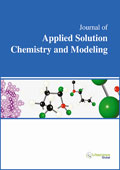jascm
|
|
Abstract: The Excess molar enthalpies have been determined for binary liquid mixtures of acetylene tetrachloride (CHCl2CHCl2) (ATC) with dimethylsulfoxide, acetone, acetonitrile and n-dibutyl ether at the temperature 303.15 K by microcalorimetry. The excess molar enthalpies are negative for all the mixtures over the whole composition range. The results were fitted with the Redlich-Kister equation by means of the least square method. The values of HE decrease in the order: Dimethylsulphoxide > acetone>acetonitrile > dibutyl ether. The same decreasing trend was observed for calculated hydrogen bond energies of these systems. These results indicate the existence of specific interactions between all these components. Keywords: Excess molar enthalpy, acetylene tetrachloride, acetone, microcalorimetry, hydrogen bonding. Download Full Article |
|
|
Abstract: Sixteen novel 2-aminobenzothiazole based dichromophoric cationic azo dyes were synthesized and their photophysical properties studied. The colors of the synthesized azo dyes were violet to blue with high molecular extinction coefficient ranged between 2.6 - 4.7× 104 (M-1.cm-1). All of the dyes showed unique fluorescence emission at a broad range of 409–494 nm. The absorption and emission spectral changes of selected dyes were also analyzed in solvents with different polarity. Furthermore, the antibacterial activities of the dyes were evaluated against gram positive and negative bacteria including S. aureus, S. epidermidis, E. coli, and P. aeruginosa and different concentrations of dyes showed an anti-gram positive bacterial activity. Keywords: Benzothiazole, Azo Dyes, Fluorescence, Cationic dye, Antibacterial, Solvatochromism. Download Full Article |
|
|
Abstract: The preferential solvation parameters by ethanol (EtOH) or propylene glycol (PG) of daidzein were derived from their solution thermodynamic properties by means of the inverse Kirkwood-Buff integrals and the quasi-lattice-quasi-chemical (QLQC) methods. According to IKBI method, the preferential solvation parameter by the co-solvent, δx1,3, is negative in water-rich mixtures but positive in co-solvent-rich mixtures in both kinds of systems. This could demonstrate the relevant role of hydrophobic hydration around the aromatic rings in the drug solvation in water-rich mixtures. Furthermore, the more solvation by co-solvent in co-solvent-rich mixtures could be due mainly to polarity effects and acidic behavior of the hydroxyl groups of the compound in front to the more basic solvents present in the mixtures, i.e. EtOH or PG. Otherwise, according to QLQC method, this drug is preferentially solvated by the co-solvents in all the mixtures in both kind of systems. Keywords: Daidzein, ethanol, propylene glycol, preferential solvation, inverse Kirkwood-Buff integrals, quasi-lattice-quasi-chemical. Download Full Article |
|
|
Abstract: Encapsulation of nonsteroidal or non-steroidal anti-inflammatory drugs (NSAID) in nanocarrier systems aims to enhance bioavailability and to decrease toxicity of these drugs and thus improve the efficacy of treatments. With this aim two types of nanoparticles were prepared and compared: lipid nanoparticles, made of cetyl palmitate and Miglyol 812 which were uncoated or coated with chitosan; or polymeric nanoparticles, made of poly (DL-lactic-co-glycolic acid) (PLGA) for which different emulsion stabilizers were also tested (poly (vinyl alcohol) (PVA), and Pluronic F68). Nanoparticles were characterized for drug content and for particle size, charge and morphology. The lipid matrix was analyzed regarding its crystallinity by differential scanning calorimetry (DSC). The size of the nanoparticles was measured by dynamic light scattering (DLS) which indicated a unimodal particle size distribution in all systems. Nanoparticles’ stability was confirmed by their highly negative surface charge in the case of polymeric and uncoated lipid nanoparticles, as analyzed by zeta potential measurements using electrophoretic light scattering (ELS). Lipid chitosan coated nanoparticles have also shown to be stable presenting highly positive surface charge. Results have further demonstrated that indomethacin is highly encapsulated regardless the type of particles. Morphological analysis by scanning electron microscopy has shown that the nanoparticles were smooth and spherical. The results gathered within the current study point to the conclusion that the proposed formulations provide nanoparticles of satisfactory quality to encapsulate indomethacin, which might be used to improve bioavailability of other NSAID in the treatment of inflammation. Keywords: NSAID, PLGA nanoparticles, nanostructured lipid carriers (NLC), encapsulation efficiency, dynamic and electrophoretic light scattering (DLS and ELS), differential scanning calorimetry (DSC), electron scanning microscopy (SEM). Download Full Article |
|
|
Abstract: Investigation on the molecular interactions between binary mixtures containing diethyl carbonate in combination with nitrobenzene, chlorobenzene and aniline is presented. Ultrasonic velocity and density values were determined for the individual components as well as binary mixtures of the above benzene derivatives with diethyl carbonate at temperatures (293.15, 298.15, 303.15, 308.15, 313.15, 318.15 and 323.15) K over the entire composition range. Further, adiabatic compressibility and acoustic impedance values were calculated using the experimental results. In addition to these parameters, the excess parameters like excess adiabatic compressibility, excess acoustic impedance and deviation in ultrasonic velocity were also obtained. Based on all these results, molecular interactions among the selected components were discussed. Keywords: Ultrasonic velocity, density, molecular interactions, binary mixtures, diethyl carbonate. Download Full Article |


